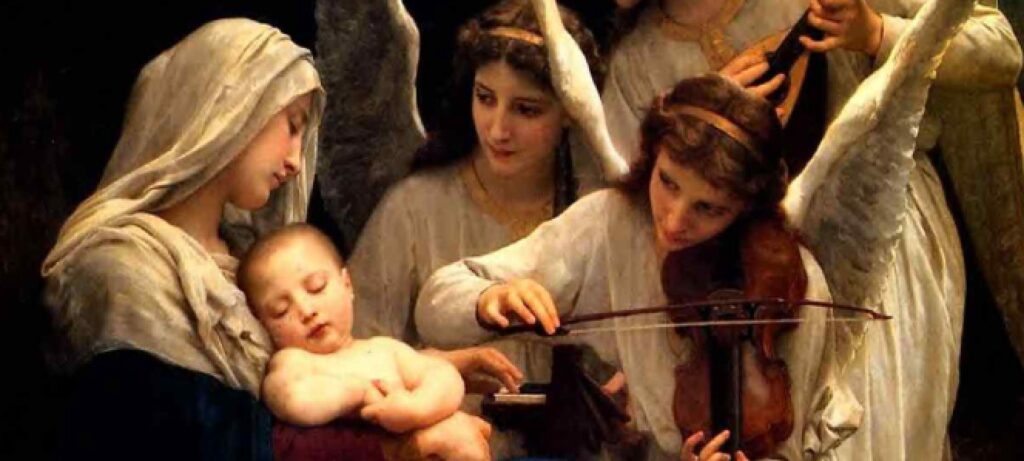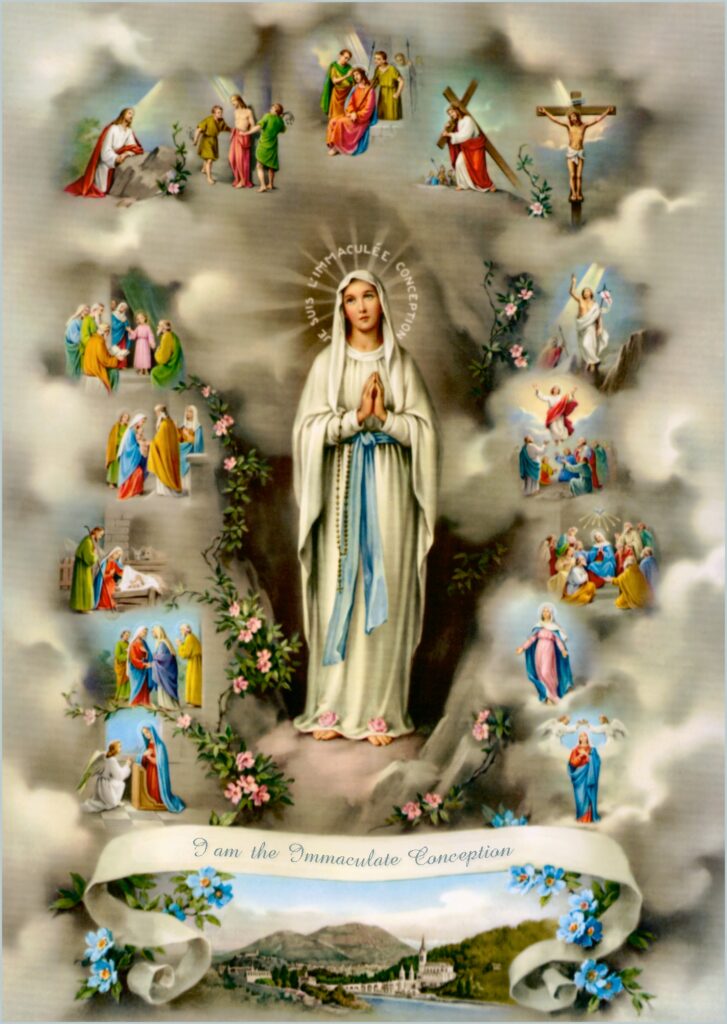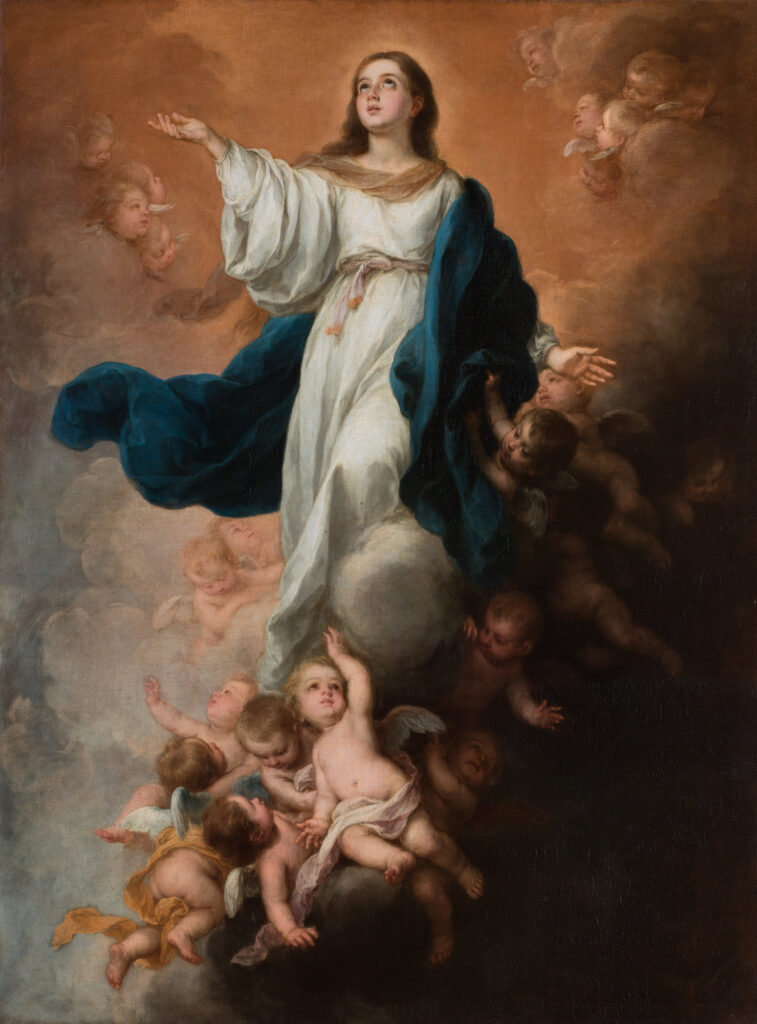Mary said, “Behold, I am the handmaid of the Lord. May it be done to me according to your word.” – Luke 1:38
There are four dogmas stating Mary’s personal relationship with God and her role in human salvation:
Divine Motherhood Perpetual Virginity Immaculate Conception The Assumption
1) Divine Motherhood
Mary’s divine motherhood was proclaimed at the Council of Ephesus in 431. Various names are used to describe Mary’s role as mother of Jesus. She is called “Mother of God” which translates the more accurately stated greek term “Theotokos” or “Birthgiver of God.”

The Council of Ephesus (431) attributed to Mary the title, Mother of God. This needs to be read against the Council’s declaration that in Christ there are two natures, one divine and one human, but only one person. Indeed, according to the Council the holy virgin is the Mother of God since she begot according to the flesh the Word of God made flesh. This decision was further explained by the Council of Chalcedon (451) which says with regard to Mary’s divine motherhood:
“…begotten from the Father before the ages as regards his godhead, and in the last days, the same, because of us and because of our salvation begotten from the Virgin Mary, the Theotokos, as regards his manhood; one and the same Christ, Son, Lord, only-begotten…”
Mary’s Divine Motherhood was not the object of an independent or exclusive dogmatic declaration. The statement is embedded in texts defining the person and natures of Jesus Christ. Thus, the dogma of Divine Motherhood becomes an integral part of the christological dogma. This does not diminish its definitive and binding character. The dogma of Divine Motherhood is generally accepted by all Christian denominations. ^TOP^
2) Perpetual Virginity
The expression perpetual virginity, ever-virgin, or simply “Mary the Virgin” refers primarily to the conception and birth of Jesus. From the first formulations of faith, especially in baptismal formulas or professions of faith, the Church professed that Jesus Christ was conceived without human seed by the power of the Holy Spirit only. Here lies the decisive meaning of expressions such as “conceived in the womb of the Virgin Mary,” “Mary’s virginal conception,” or “virgin birth.” The early baptismal formula (since the 3rd century) state Mary’s virginity without further explaining it, but there is no doubt about its physical meaning. Later statements are more explicit. Mary conceived “without any detriment to her virginity, which remained inviolate even after his birth” (Council of the Lateran, 649).

Although never explicated in detail, the Catholic Church holds as dogma that Mary was and is Virgin before, in and after Christ’s birth. It stresses thus the radical novelty of the Incarnation and Mary’s no less radical and exclusive dedication to her mission as mother of her Son, Jesus Christ. Vatican II reiterated the teaching about Mary, the Ever-Virgin, by stating that Christ’s birth did not diminish Mary’s virginal integrity but sanctified it . The Catechism of the Catholic Church ponders the deeper meaning of the virgin bride and perpetual virginity (499-507). It also maintains that Jesus Christ was Mary’s only child. The so-called “brothers and sisters” are close relations. ^TOP^
3) Immaculate Conception
The solemn definition of Mary’s Immaculate Conception is like Divine Motherhood and Perpetual Virginity part of the christological doctrine, but it was proclaimed as an independent dogma by Pope Pius IX in his Apostolic Constitution “Ineffabilis Deus” (December 8, 1854). Though highlighting a privilege of Mary it in fact stresses the dignity and holiness required to become “Mother of God.” The privilege of the Immaculate Conception is the source and basis for Mary’s all-holiness as Mother of God.

More specifically, the dogma of the Immaculate Conception states “that the most Blessed Virgin Mary, from the first moment of her conception, by a singular grace and privilege from Almighty God and in view of the merits of Jesus Christ, was kept free of every stain of original sin.”
This dogma has both a “negative” and a “positive” meaning which complement each other. The “negative” meaning stresses Mary’s freedom from original sin thanks to the anticipated or retroactive (here called preventive) grace of Christ’s redemptive act. By the same token, the dogma suggests Mary’s all-holiness. This “positive” meaning is the consequence of the absence of original sin. Mary’s life is permanently and intimately related to God, and thus she is the all-holy.
Although difficult to explain, original sin provokes disorderliness in thought and behavior, especially with regard to the primacy of God’s presence in our life. Consequently, in declaring Mary immaculately conceived, the Church sees in Mary one who never denied God the least sign of love. Thus, the dogma declares that from her beginning Mary was exceptionally holy and in constant union with the sanctifying grace of the Holy Spirit. ^TOP^
4) The Assumption
This marian dogma was proclaimed by Pope Pius XII on November 1, 1950 on his Encyclical Munificentissimus Deus. A distinction needs to be made between Ascension and Assumption. Jesus Christ, Son of God and Risen Lord, ascended into heaven, a sign of divine power. Mary, on the contrary, was elevated or assumed into heaven by the power and grace of God.

The dogma states that “Mary, Immaculate Mother of God ever Virgin, after finishing the course of her life on earth, was taken up in body and soul to heavenly glory.” This definition as well as that of the Immaculate Conception makes not only reference to the universal, certain and firm consent of the Magisterium but makes allusion to the concordant belief of the faithful. The Assumption had been a part of the Church’s spiritual and doctrinal patrimony for centuries. It had been part of theological reflection but also of the liturgy and was part of the sense of the faithful.
This dogma has no direct basis in scripture. It was nonetheless declared “divinely revealed,” meaning that it is contained implicitly in divine Revelation. It may be understood as the logical conclusion of Mary’s vocation on earth, and the way she lived her life in union with God and her mission. The assumption may be seen as a consequence of Divine Motherhood. Being through, with, and for her Son on earth, it would seem fitting for Mary to be through, with, and for her Son in heaven, too. She was on earth the generous associate of her Son. The Assumption tells us that this association continues in heaven. Mary is indissolubly linked to her Son on earth and in heaven.
In heaven, Mary’s active involvement in salvation history continues: “Taken up to heaven, she did not lay aside her salvific duty … By her maternal love she cares for the brothers and sisters of her Son who still journey on earth” (LG). Mary is the “eschatological icon of the Church” (CCC 972), meaning the Church contemplates in Mary her own end of times.
The definition of the dogma does not say how the transition from Mary’s earthly state to her heavenly state happened. Did Mary die? Was she assumed to heaven without prior separation of soul and body? The question remains open for discussion. However, the opinion that Mary passed through death as her Son did, has the stronger support in tradition.
Glorified in body and soul, Mary is already in the state that will be ours after the resurrection of the dead. ^TOP^
SOURCE: Catholic News Agency